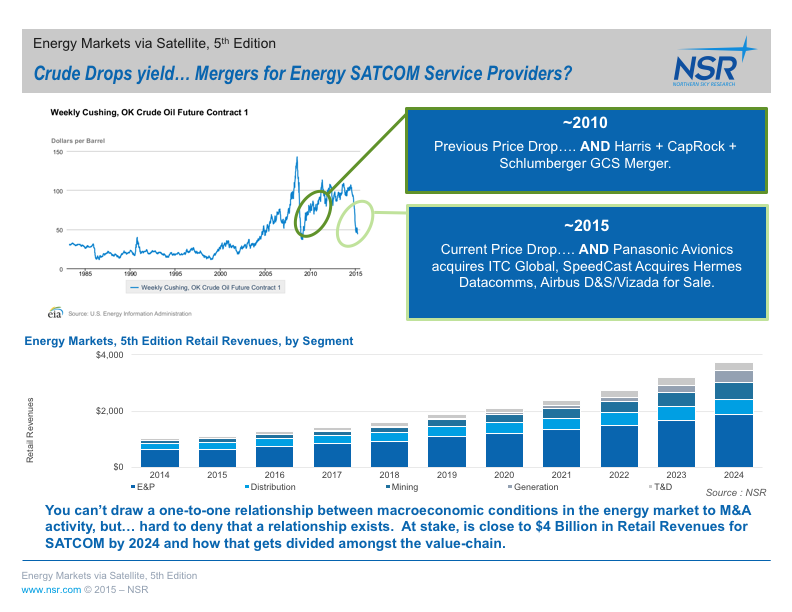Buying Low in Energy Satcom
Mar 25th, 2015 by
Brad Grady, NSR
Not since the 2010 merger of Harris-CapRock-Schlumberger GCS has
there been change amongst the larger Energy market service providers.
However, over the past two weeks Panasonic Avionics Corp. acquired ITC
Global, and SpeedCast acquired Hermes Datacomms and Geolink Satellite
Services. Meanwhile, Airbus Defense & Space’s commercial SATCOM service
division (Vizada), which has a strong presence in the Offshore Support
Vessel market, remains for sale. Although it is hard to put a
one-to-one relationship between energy market commodity prices (such as
crude oil or iron ore), it’s hard to deny that there isn’t at
least a casual relationship between them.

As NSR noted in 2011 when the Harris-CapRock-Schlumerger GCS M&A
occurred, the impending introduction of HTS capacity into the
mobility markets is at-part a consideration of ‘buying
end-users’ to increase returns on capacity investments. With the
Airbus D&S/Vizada sale still on the market, service providers
are taking the first steps in expanding market share and diversifying
the vertical markets they serve. For Panasonic, they get
the benefit of levering geographic, frequency, and growth rate diversity
between the core satellite mobility markets – Aeronautical and
Maritime/Energy to further improve their economics of scale to their
extensive HTS footprint. For SpeedCast, Hermes is yet another
company in a steady string of acquisitions over the past months to
increase their presence in the energy sector – and, further increase
their presence outside of Asia-Pacific. With aims at becoming a
‘Top 3 player in the energy services space’ there is still probably some
additional organic and inorganic growth in the SpeedCast playbook.
Looking forward, not only is the M&A activity likely to
continue until the market reaches a new equilibrium around
crude oil prices, but now is the time for service providers to
encourage end-users to look at new technologies to improve operations.
Just as NSR found in its Energy Markets via Satellite, 5th
Edition – the timing of crude oil price collapse couldn’t be
better timed for the satellite sector. As a traditionally
conservative market, energy market end-users were more likely to embrace
the ‘if it aint broke, only change it a little’ approach to acquiring
satellite capacity – add a few (or a few dozen depending on the specific
sub-segment) Mbps over existing systems and maybe migrate from FSS
C-band to FSS Ku-band but, largely wait until HTS options fully mature
before jumping on the bandwidth wagon. Now, O&G end-users
are looking towards improving operational efficiencies (both in
terms of better ‘return’ on their spending, and expanding automation
and/or data-centric processes to their remote operations.) All said,
new offerings leveraging HTS from GEO, MEO, and in the future
LEO, are likely to meet lower resistance from the boardroom
With NSR projecting $4 Billion in Retail Revenues from FSS, HTS and
MSS Satellite Communication services by 2024 from the Energy Sector
(O&G, Mining, and Electrical Utilities), this changing mindset will help
be a key growth driver over the next ten years. For service
providers and the value-chain in general, it also opens the door for
‘non-traditional’ or lower-tier players to compete with the
bigger brand names. Although track record and legacy will
be big hurdles to overcome, the bar has likely dropped a bit
as end-users question ‘what they’ve always done.’
Bottom Line
Although disruption to energy market commodity prices is not a
necessary condition for greater M&A activity in the SATCOM markets…
it is definitely sufficient. Furthermore, as the
market settles into a new equilibrium, expect the door into the CIO’s
office to be open a bit wider to new technologies, and new players than
it might have otherwise. However, the core metrics of
success still remain – right service, right location, right price.
| |